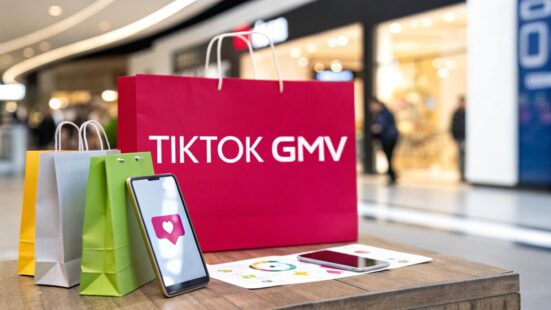 Your Guide to Influencer Marketing Agreements
Your Guide to Influencer Marketing Agreements
Let's be honest, when most people think of TikTok, they think of viral dances, funny skits, and maybe some questionable life hacks. But for e-commerce brands, there's a much more important number to watch than likes or views: Gross Merchandise Value, or GMV.
So, what exactly is GMV?
Think of it as the total dollar amount rung up at the cash register for every single product sold through TikTok Shop. It's the complete, unfiltered sales value of all goods changing hands on the platform before you account for things like seller fees, discounts, or returns. This isn’t a fluffy engagement metric; it's a hard number that tracks real-world commerce.
Table of Contents
Why TikTok GMV Is the Pulse of Social Commerce
Imagine TikTok as a giant, sprawling digital mall where the line between entertainment and shopping has completely vanished. In this mall, every creator's video is a potential storefront, and every viral trend is a new wing opening for business.
The platform's GMV is simply the grand total of sales from every single one of those storefronts combined. It’s a direct measure of the platform’s economic heartbeat and its incredible power to turn casual scrolling into actual spending.
This number is a critical vital sign for e-commerce brands for a few key reasons:
- It Measures Real Purchase Intent: GMV cuts through the noise. It tells you, in no uncertain terms, that users aren't just watching videos—they're pulling out their wallets and buying things.
- It Signals Platform Trust: When millions of people are willing to spend money directly through TikTok Shop, it shows a deep level of trust in the platform's security and reliability. That’s a huge barrier to overcome, and TikTok has clearly done it.
- It Reveals Market Potential: A high and climbing GMV proves there's a massive, active consumer base ready to shop. This makes it an incredibly attractive channel for any brand looking to grow.
To help you get a firm grasp on this concept, here’s a quick breakdown:
Understanding TikTok GMV at a Glance
| Concept | What It Measures | Why It's Important for Brands |
|---|---|---|
| Gross Merchandise Value (GMV) | The total sales value of all goods sold through TikTok Shop, before any deductions. | It's a raw indicator of consumer spending and the platform's overall commercial health. |
| Platform Growth | The rate at which GMV is increasing over time. | A rising GMV signals a growing market and a prime opportunity for brand investment. |
| Consumer Behavior | The willingness of users to make purchases directly within the app. | Shows that TikTok has successfully converted passive viewers into active shoppers. |
Ultimately, this table shows that GMV is more than just a big number; it's a reflection of a fundamental shift in how people discover and buy products online.
The Scale of TikTok's Commercial Engine
The growth of TikTok's e-commerce arm hasn't just been fast—it's been explosive. What started as a social media app has rapidly morphed into a genuine commerce titan.
Recently, the platform's total Gross Merchandise Value doubled, hitting a mind-boggling $30 billion globally. This incredible surge isn't just a fluke; it's built on the foundation of its hyper-engaged community of over 1.2 billion daily active users. You can dig deeper into TikTok's impressive user growth and what it means for brands to see just how big the audience is.
Understanding TikTok GMV is the first step toward a crucial mindset shift. It’s about seeing the platform not just as a place for brand awareness, but as a powerful, direct-to-consumer sales engine capable of driving serious revenue.
At the end of the day, keeping an eye on the platform's overall GMV helps you benchmark your own brand's potential. It gives you the context to set ambitious but realistic sales goals and truly grasp the scale of the social commerce opportunity. For any brand selling online today, ignoring this metric means you're ignoring one of the biggest and most important shifts happening in digital retail.
The Difference Between TikTok GMV and Platform Revenue
This is a classic point of confusion: Are the total sales happening on TikTok the same as the money TikTok itself pockets? The short answer is a hard no, and getting this distinction right is crucial for any brand selling on the platform. While the two figures are related, they measure completely different things.
Let's use an analogy. Think of TikTok as a massive, bustling digital farmers market.
Gross Merchandise Value (GMV) is the total cash all the farmers (that's you and other brands) generate from selling their produce (your products) to the shoppers. It’s the grand total of every single sale that takes place inside that market.
On the other hand, TikTok's platform revenue is what the market owner (TikTok) collects for providing the real estate and drawing in all the foot traffic. This income is pulled from a few key streams.
How TikTok Earns Its Revenue
TikTok has built a seriously smart, multi-layered business model where your success as a seller feeds directly into its own bottom line. Here’s where its money comes from:
- Commissions on Sales: For every sale you ring up through TikTok Shop, the platform skims a small percentage or a flat fee. This is the most direct bridge between your GMV and TikTok's revenue.
- Advertising Spend: This is the big one—TikTok's primary revenue engine. Brands pay to run all sorts of ads, from In-Feed videos to massive TopView takeovers, to grab more eyeballs and drive their own sales.
- In-App Purchases: This bucket includes things like users buying virtual "Coins" to tip creators during livestreams and other digital goodies.
This visual does a great job of showing how a single creator's sales performance connects to the much larger GMV picture.

As you can see, individual creators track their own sales, which are a fundamental piece of the platform's overall GMV.
The Symbiotic Relationship
So, while GMV and revenue are different metrics, they're deeply connected. A rising GMV means more transactions are happening, which naturally generates more commission revenue for TikTok. This gives the platform a powerful incentive to keep rolling out and refining its shopping features, making it even easier for you to sell.
The success of TikTok Shop, now measured by a massive $30 billion GMV, has become a core pillar of the platform's financial health, even with advertising still being the main money-maker.
This financial loop is crystal clear when you look at the numbers. TikTok's total platform revenue climbed to an estimated $25 billion—a jaw-dropping 42.8% jump from the previous year. While advertising makes up most of that, the explosive growth of its e-commerce arm is impossible to ignore. For a deeper dive, you can check out more data on TikTok's explosive financial growth at Coolnerdsmarketing.com.
It all comes down to this: TikTok is heavily invested in your success because when you win, they win.
How to Calculate GMV for Your Own Brand on TikTok
While it’s great to know the overall health of the TikTok marketplace, the number that really matters for your brand is your own Gross Merchandise Value. This is where the metric comes down from the clouds and gets planted firmly in your day-to-day operations.
Calculating your brand's GMV gives you a clear, honest look at your sales performance on TikTok, without any confusing jargon getting in the way.
Fortunately, the formula is refreshingly simple. It’s a straightforward calculation that gets right to the point.
GMV = (Sale Price of Product) x (Number of Products Sold)
This formula zeros in on the top-line revenue from product sales before you start subtracting costs. It’s all about measuring the total value of the merchandise that your customers have committed to buying from you.
A Practical Calculation Example
Let's say you run a small e-commerce brand selling handmade jewelry. A user-generated video showing off your new necklace suddenly goes viral, and your TikTok Shop sales start popping off.
To figure out your GMV for that one necklace for the month, you’d just do this:
- Sale Price: Your necklace sells for $50.
- Number of Products Sold: You sold 120 necklaces in one month.
- Calculation: $50 (Sale Price) x 120 (Units Sold) = $6,000 GMV
It's that easy. That $6,000 figure represents the total value of necklaces sold, giving you a clean snapshot of that product's viral moment. Your total brand GMV would simply be the sum of the GMV from every product you sold in your TikTok Shop.
This kind of viral moment really shows the power of authentic content. For brands wanting to make this happen for themselves, it’s crucial to learn how to create UGC content that actually connects with the TikTok audience.
What to Exclude for an Accurate GMV
To keep your GMV calculation clean and consistent, it's critical to leave out any extra costs or changes that happen after the initial sale. This ensures you're measuring the gross sales value, not your net profit.
Always leave these out:
- Shipping and Handling Fees: Think of these as operational costs. They aren't part of the product's actual value.
- Taxes: Sales tax is something you collect for the government; it's not revenue you've earned.
- Returns and Refunds: GMV is a snapshot taken at the point of sale. You’ll track returns separately as a deduction from your gross revenue, not as a change to your GMV.
By isolating the core transaction value, you get a reliable metric you can use to track growth, see how well your campaigns are doing, and set smart sales goals for your brand on TikTok.
Actionable Strategies to Increase Your TikTok GMV

Alright, so you know what TikTok GMV is and how to calculate it. That's the first step. The real goal, though, is making that number climb higher and higher.
Moving from theory to actual profit means you need a solid playbook. This isn't about vague advice; let's get into the specific, actionable tactics top e-commerce brands are using right now to turn views into revenue and send their GMV soaring.
Master the Art of TikTok Live Shopping
TikTok Live is so much more than a simple broadcast. Think of it as an interactive, real-time sales event. The brands that absolutely kill it on Live create an atmosphere of genuine excitement and urgency that you just can't replicate with standard posts.
The key is to make your live sessions an unmissable experience. Here’s how to turn your TikTok Live events into a major GMV driver:
- Create Time-Sensitive Offers: Announce exclusive, limited-time discounts or product bundles that are only available to viewers during the live stream. This scarcity gives people a powerful reason to buy right now.
- Run Flash Sales: Keep viewers on their toes by announcing surprise price drops on popular items for super short periods, like 5-10 minutes. This keeps them glued to the screen and ready to act fast.
- Showcase Products in Action: Don't just talk about your products—demonstrate them! Unbox new items, show exactly how they work, and answer audience questions in real-time. This builds incredible trust and knocks down any hesitation to buy.
Optimize Your TikTok Shop Listings
Think of your TikTok Shop as your digital storefront. A messy, confusing shop can stop a sale dead in its tracks, no matter how awesome your video content is. It's all about merchandising your digital shelves for maximum appeal.
A high-converting TikTok Shop page needs these elements:
- High-Quality Visuals: Use crisp, vibrant images and short video clips for every single product listing. Show your product from multiple angles and, more importantly, in a real-life context.
- Compelling Product Descriptions: Write clear, punchy, and benefit-focused descriptions. Use bullet points to make key features easy to scan and show how your product solves a customer's problem.
- Visible Social Proof: Actively encourage customer reviews and ratings, and then display them proudly. Let's be honest, positive feedback from other buyers is one of the most powerful conversion tools you have.
A seamless shopping experience is everything. If your logistics can't keep up with your sales, you're going to damage customer trust and hurt your reputation. For a deeper dive, check out these key strategies to maximize TikTok Shop sales through 3PL fulfillment to make sure your backend operations can handle your growth.
Partner with Authentic Creators
Creator partnerships are the absolute lifeblood of TikTok commerce. But the goal isn't just finding someone with a massive follower count; it's about finding the right partner whose audience genuinely trusts what they have to say. Authenticity is what drives sales.
Look for creators who have a natural love for your brand and a real knack for engaging their community. A well-run creator campaign feels less like an ad and more like a trusted friend sharing a cool new find. This approach is the core of a strong user-generated content strategy, which builds credibility and drives organic interest. To really nail this, it's worth learning how to develop an effective user-generated content strategy to guide your collaborations.
When you combine exciting live events, a polished storefront, and authentic creator partnerships, you create a powerful, multi-pronged attack for boosting your TikTok GMV.
Tools to Track and Analyze Your TikTok Sales Performance
You can't improve what you don't measure. But tracking your TikTok GMV isn't about getting lost in spreadsheets—it’s about creating a simple routine to understand what’s working and what isn't. Lucky for us, TikTok provides some pretty powerful native tools to get started.
Your main hub for all sales data is the TikTok Seller Center. Think of it as your command center for everything related to commerce on the platform. Inside the dashboard, you’ll find detailed reports and analytics that break down your sales performance over specific timeframes.
Here’s a quick peek at the main dashboard in the TikTok Seller Center.
This dashboard gives you a great at-a-glance overview of key metrics, including your top-selling products, live stream performance, and overall sales trends. Making a habit of checking this area is the first step toward making decisions based on real data, not just gut feelings.
Integrating for a Holistic View
While the Seller Center is fantastic for platform-specific data, the real magic happens when you integrate it with third-party e-commerce platforms like Shopify. This sync gives you a complete picture of your business. You can see your TikTok sales right alongside revenue from your website and other channels, giving you a single source of truth for your overall performance.
This unified view helps you understand the true impact of your TikTok marketing. For instance, you can easily connect a viral video to a sales spike across all your storefronts, not just on TikTok Shop. It’s about seeing the full ripple effect.
Beyond just raw numbers, understanding your sales performance requires robust analytics. For more on this, explore these effective social media analytics reporting strategies to build more comprehensive reports.
This deeper level of analysis is especially critical when you're working with creators. Tracking the direct impact their content has on your bottom line is fundamental. You can dive deeper into how to measure influencer marketing ROI to make sure your partnerships are genuinely driving growth.
Ultimately, creating a consistent tracking routine—whether it's daily, weekly, or monthly—is the key. It's how you turn raw data into actionable insights that actually fuel your brand’s growth.
How to Benchmark Your Growth Against Platform Trends

So you've calculated your GMV. That’s a great start, but the number itself doesn't tell the whole story. Is it good? Average? Lagging? Without context, it’s just a number floating in a vacuum.
To really understand your performance, you have to benchmark your brand against the massive commercial currents flowing through TikTok itself.
Think of it like this: if you’re captaining a small boat, knowing your own speed is important. But what’s truly critical for getting anywhere is understanding the speed and direction of the ocean’s tide. Platform-wide trends are that tide. They don’t set impossible targets, but they show you the real scale of the opportunity and the momentum you can catch.
Use Regional Trends as Your Compass
TikTok's commercial power isn't the same everywhere. It's a collection of huge regional markets, each moving at its own pace. What’s considered "good" GMV for a brand in one country might look totally different somewhere else. Context is everything.
The platform's global footprint is insane, with an estimated 1.6 billion monthly active users. A massive 51% of them are in the Asia-Pacific region, making it the undisputed heart of TikTok commerce. But don't sleep on other markets. North America holds 11.8% and Latin America grabs 18.3% of the user base. In the U.S. alone, the platform has a crazy amount of sway with around 136 million users, which is a massive domestic market. You can dig into a full breakdown of TikTok's global user distribution on Business of Apps.
This regional data isn't just trivia; it's a strategic compass for your brand. If you're selling mostly in the United States, your benchmark for growth should be based on American trends, not some global average that doesn’t apply to you.
Set Realistic GMV Goals
Once you have this bigger picture, you can stop guessing and start setting informed goals. Your TikTok GMV targets should be tailored specifically to your brand, considering both what’s happening on the platform and what’s realistic for your business.
Benchmarking isn't about comparing your day-one startup to a global giant. It's about making sure your growth is keeping up with the platform's incredible commercial speed and setting real-world goals based on your product category and where your business is at.
Here’s a simple way to think about setting your benchmarks:
- Your Category: Are you in a hot-ticket niche like beauty or fashion, or a smaller, more specialized market? Find data on how your specific category is performing to set a relevant baseline.
- Your Business Stage: For a new brand, a steady 15-20% month-over-month GMV increase might be a fantastic goal. An established brand, however, might be more focused on hitting specific sales targets tied to major campaigns or holiday seasons.
By understanding where the market is headed, you can set ambitious—but achievable—GMV goals. This ensures you’re not just growing, but growing at the speed of TikTok.
Still Have Questions About TikTok GMV?
As you start digging into TikTok commerce, you're bound to have some questions pop up. That's totally normal. Getting the hang of Gross Merchandise Value is all about understanding the little details so you can set smarter goals and build a sales strategy that actually works.
Let's tackle some of the most common questions we hear from brands.
What’s a Good GMV for a Small Business on TikTok?
This is the million-dollar question, but honestly, there's no single magic number. What’s “good” is completely relative. It all comes down to your industry, how much your products cost, and where you are in your business journey. A brand selling $150 jackets will have a totally different GMV target than a shop selling $15 craft supplies.
Forget chasing a specific dollar amount. The real metric you should obsess over is your growth rate. For a new brand, a healthy goal is to aim for a steady 10-20% month-over-month increase in GMV. This shows you're learning, testing, and finding what resonates.
Focusing on that consistent, step-by-step growth is way more powerful than getting hung up on an arbitrary number.
Does TikTok GMV Include Returned Products or Shipping Fees?
Nope, and this is a really important distinction for keeping your books straight.
- Gross Merchandise Value (GMV) is a snapshot of the total value of products sold at the moment of the transaction. It's the top-line, pre-deduction figure.
- Net Sales is the number you look at after you've subtracted the cost of returns and refunds.
Think of GMV as your total sales potential before things like shipping, taxes, and returns are factored in. You absolutely need to track those costs separately to understand your true, take-home profit.
How Often Should I Track My TikTok GMV?
You can't manage what you don't measure. For most e-commerce brands, checking in weekly hits the sweet spot. It's frequent enough that you can:
- Catch sales trends as they're happening.
- See the immediate results from a new video or campaign.
- Quickly pivot your content or ad spend if something isn't working.
On top of that, it's smart to do a bigger, more strategic review at the end of each month. This is where you'll look at your overall growth path and plan your next big moves.
Ready to connect with authentic TikTok creators who can help send your GMV soaring? JoinBrands provides the tools and talent to accelerate your sales. Find the perfect partners for your next campaign.








